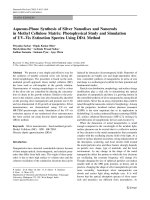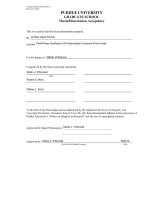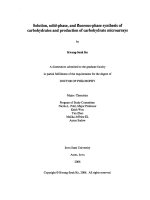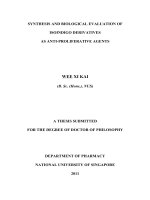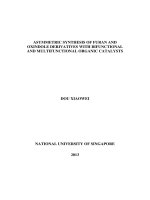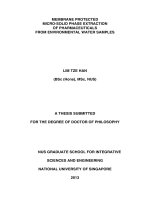Solid phase synthesis of purine derivatives
Bạn đang xem bản rút gọn của tài liệu. Xem và tải ngay bản đầy đủ của tài liệu tại đây (3.06 MB, 212 trang )
SOLID-PHASE SYNTHESIS OF PURINE DERIVATIVES
FU HAN
(M.Sc., FUDAN UNIVERSITY)
A THESIS SUBMITTED
FOR THE DEGREE OF DOCTOR OF PHILOSOPHY
DEPARTMENT OF CHEMISTRY
NATIONAL UNIVERSITY OF SINGAPORE
2006
ACKNOWLEDGEMENTS
A very special thank you to my supervisor, Dr. Lam Yulin for her guidance,
encouragement and patience, which have been a tremendous help for me throughout the
entire course of my Ph.D. study. She showed me her wide knowledge and stimulating
suggestions during many hours of discussions we had. And most of all she gave me
untiring help during my difficult moments.
I would like to gratefully acknowledge the support of Dr. Teresa Tan in Dept. of
Biochem., who gave me the chance to do the biological test in her lab. My special thanks
to Yang Fei for her help on biological experiments. And I also want to thank Dr. Go Mei
Lin and Leng Zhijin for their help on microwave-assistant reactions.
I also wish to thank all my group members, Madam Liang Eping, Kong Hah Hoe, Mark
Tan Kheng Chuan, Makam Shantha Kumar Raghavendra, He Rongjun, Gao Yongnian,
and Soh Chai Hoon⎯for all the help and interesting hints. Their support has been great.
I want to express my gratitude to Han Yanhui and Peggy Ler, for their help with
performing NMR spectra analyses. And thanks to Wong Lai Kwai and Lai Hui Ngee,
who have helped me with mass spectral analyses.
I am deeply indebted to my husband, whose patience and understanding I am very
thankful for. My deepest gratitude is reserved for my parents for their long-distance
support and love.
I would like to thank National University of Singapore for awarding me a research
scholarship to pursue my doctorate degree.
i
TABLE OF CONTENTS
TABLE OF CONTENTS
i
SUMMARY
iv
LIST OF TABLES
vi
LIST OF FIGURES
vii
LIST OF ABBREVIATIONS
ix
LIST OF PUBLICATIONS
xiv
CHAPTER 1: INTRODUCTION 1
1.1 Solid-phase synthesis (SPS) 1
1.1.1 Solid supports 2
1.1.2 Linkers 3
1.1.3 Reaction monitoring in solid-phase synthesis 13
1.1.4 Solid-phase synthetic libraries from peptides to small organic molecules 13
1.2 Solid-phase synthesis of purine 15
1.2.1. SPS of purines based on halogenated/aminated purine 16
1.2.2. SPS of purine based on purine ring construction 24
1.3 Purpose of the research work in this thesis 27
1.4 References 28
CHAPTER 2: DESIGN, SYNTHESIS AND BIOLOGICAL EVALUATION OF 2,9-
DISUBSTITUTED-6-OXOPURINES AS INHIBITORS OF MULTIDRUG
RESISTANCE PROTEIN (MRP4/ABCC4)
31
ii
2.1 Introduction 31
2.1.1 Importance of purine 31
2.1.2 Multidrug resistance protein (MRP) 32
2.2 Outline of our synthetic strategy 33
2.3 Results and discussions 34
2.3.1 Solution-phase study 34
2.3.2 Solid-phase Study 42
2.3.3 Biological evaluation of 2,9-disubstituted-6-oxopurines as MRP4 inhibitor 51
2.4 Conclusions 55
2.5 Experimental 55
2.6 References 74
CHAPTER 3: TRACELESS SOLID-PHASE SYNTHESIS OF 1,7-DISUBSTITUTED
PURINES
77
3.1 Introduction 77
3.2 Outline of our strategy 78
3.3 Results and discussions 79
3.3.1 Solution-phase synthesis study 79
3.3.2 Solid-phase study 88
iii
3.4 Conclusion 91
3.5 Experimental 92
3.6 References 104
CHAPTER 4: TRACELESS SOLID-PHASE SYNTHESIS OF VARIOUS
SUBSTITUTED PURINES FROM p-BENZYLOXYBENZYLAMINE (BOBA) RESIN
105
4.1 Introduction 105
4.2 Outline of our strategy 106
4.3 Results and discussions 107
4.3.1 Solution-phase study towards 1,7,8-trisubstituted purines 107
4.3.2 Solution-phase study of other various substituted purines 117
4.3.3 Solid-phase study 131
4.4 Conclusions 137
4.5 Experimental 139
4.6 References 163
APPENDIX A: X ray crystal data 164
APPENDIX B: Spectral analyses 176
iv
SUMMARY
This thesis reports the development of novel methodologies for the solid-phase synthesis
of purine derivatives.
The first project involves the solid-phase synthesis of 2,9-disubstituted-6-oxopurines
using Wang resin. The synthetic strategy involves loading 6-chloropurine scaffolds
directly onto the solid support via an ether linker. Following this, combinatorial
modifications include Mitsunobu alkylation at the N9 position, amination or Sonogashira
coupling at the C2 position, bromination and subsequent alkylation at the C8 position
were carried out. Then resin was eventually cleaved and 2,9-disubstituted-6-oxopurines
were released. A small library of purine derivatives was prepared and overall yields
obtained were 24-70%. The effects of these compounds on multidrug resistance protein 4
(MRP4/ABCC4) facilitated bimane-GS efflux were examined. Compounds 2-16 and 2-
25d were active in inhibiting MRP4 mediated efflux of the bimane-glutathione conjugate.
In addition, both compounds were also able to reverse MRP4 mediated resistance to the
anti-cancer drug 6-thioguanine.
The second project focuses on the investigation of the regioselective solid-phase
synthesis of N7-substituted purine using REM resin. The synthetic strategy was devised
to anchor the REM resin at N9 of 6-chloropurine via Michael addition, leaving N7 as the
steric priority for alkylation. Subsequent hydrolysis of 6-chloride was carried out
followed by alkylation at N1. The resin bound N1-substituted purine was then
quaternized at N7 with different alkylation agents. The 1,7-disubstituted-6-oxopurine
derivatives were released from the resin via Hofmann elimination. With this method, a
library of 15 1,7-disubstituted-6-oxopurines was synthesized in high purity and good
v
yields. This study gives the first example of a highly regioselective solid-phase synthesis
of 1,7-disubstituted-6-oxopurine derivatives.
The third project centers on widening the solid-phase synthesis of purines based on the
purine ring construction strategy. The synthetic strategy was designed to load the 5-
amino-4,6-dichloropyrimidine onto BOBA resin via an amine linker to construct the
diamine key intermediate for elaboration to various substituted purines. After cyclization,
the N7 position possesses the steric priority to be alkylated. This, in turn, resulted in a
regioselective N7 alkylation being achieved. At the end of the reaction, the BOBA linker
was easily cleaved and the target purines were released. During this study, we have also
extended the use of the key intermediate polymer supported diamine for other solid-phase
synthesis including 1,7,8-trisubstituted purines, 8-unsubstituted purines, 8-azapurines and
[i]-condensed purines.
In all these three projects, solid-phase-oriented synthesis in solution was examined to
establish the requisite solid-phase reaction conditions.
vi
LIST OF TABLES
Table 1.1 Acid labile solid-phase linkers
5
Table 2.1
Synthesis of compound 2-4a 36
Table 2.2
Effects of 2-16 and 2-25d on bimane-GS efflux 52
Table 2.3
Viability of M and V following exposure to 2-16 and 2-25d 53
Table 2.4
IC
50
for 6TG in the presence of the purine derivatives 54
Table 2.5
Effects of inhibitors on MRP4-mediated efflux of bimane-GS 54
Table 3.1
Synthesis of compound 3-2 80
Table 3.2
Solution-phase synthesis of compound 3-5 86
Table 4.1
Synthesis of compound 4-2a 109
Table 4.2
Various ring closure conditions applied on 4-9 112
Table 4.3
Cyclization with aldehyde 114
Table 4.4
Different hydrolysis conditions of 4-13a 120
vii
LIST OF FIGURES
Figure1.1
Illustration of a solid-phase synthesis 1
Figure 1.2
Structure of Wang resin 4
Figure 1.3
Silyl linkers for traceless SPS 9
Figure 1.4
Purine structure and numbering 16
Figure 2.1
Structures of hypoxanthine and guanine 31
Figure 2.2
X ray crystal structure of 2-3 35
Figure 2.3
X ray crystal structure of compound 2-4b 38
Figure 2.4
Library of 6-oxopurine derivatives 45
Figure 2.5
X ray Crystal Structure of 2-23a 46
Figure 2.6
X ray Crystal Structure of 2-23b 46
Figure 2.7
X ray Crystal Structure of 2-23d 47
Figure 2.8
NOESY spectrum of 2-25a 49
Figure 2.9
NOESY spectrum of 2-26 50
Figure 2.10
Structure of compound 2-6 58
Figure 2.11
Structure of compound 2-22e 67
Figure 3.1
9-H and 7-H purine 77
Figure 3.2
NOESY spectrum of compound 3-4 83
Figure 3.3
NOESY spectrum of compound 3-4a 84
Figure 3.4
NOESY spectrum of compound 3-4b 85
Figure 3.5
Library of 1,7-disubstituted-6-oxopurine 90
Figure 3.6
X-ray crystal structure of 3-6f 91
viii
Figure 4.1
Structure of 9-(4-(benzyloxy)benzyl)-6-chloro-8-hexyl-
9H-purine (4-12)
114
Figure 4.2
X ray crystal structure of 4-13a 119
Figure 4.3
X ray crystal structure of 4-18a 122
Figure 4.4
Structures of side products 4-25 and 4-26 125
Figure 4.5
NOESY of compound 4-21a 126
Figure 4.6
Two possible pathways of the cyclization of the pendant
alcohol
127
Figure 4.7
NOESY of compound 4-21b 129
Figure 4.8
NOESY of compound 4-23 130
Figure 4.9
X ray crystal structure of compound 4-6i 133
Figure 4.10
X ray crystal structure of compound 4-17b 135
Figure 4.11
X ray crystal structure of compound 4-17c 135
Figure 4.12
Library of various substituted purines 138
ix
LIST OF ABBREVIATIONS
δ
chemical shift in ppm
AcOH acetic acid
aq aqueous
bimane-GS bimane-glutathione
Bn benzyl
n
Bu n-butyl
BOBA resin p-benzyloxybenzylamine resin
Bpoc 2-(biphenyl)-isopropyloxycarbonyl
BuOH n-butanol
calcd calculated
CAN ceric ammonium nitrate
CDK cyclin-dependent kinase
d doublet
DABCO 1,4-diazabicyclo-[2.2.2]octane
DBU diazabicyclo[5.4.0]undec-11-ene
DEPT distortionless enhancement of polarization transfer
dd doublet of doublets
DiAD diisopropyl azodicarboxylate
dt doublet of triplets
DCM dichloromethane
DHP 3,4-dihydro-[ 2H ]-pyran
x
DiEA N,N-diisopropylethylamine
DMA N,N-dimethylacetamide
DMEM Dulbecco’s modified eagle medium
DMF N,N-dimethylformamide
DMSO dimethylsulfoxide
DVB divinylbenzene
equiv. equivalent
EI electron ionization
ESI electrospray ionization
Et
2
O diethyl ether
EtOAc ethyl acetate
Fmoc 9-fluorenylmethoxycarbonyl
FTIR fourier trasform infrared spectroscopy
HAL hypersensitive acid labile
HBSS Hank’s balanced salt solution
HFIP hexafluoroisopropanol
HMDS hexamethyldisilazane
HRMAS high resolution magic angle spinning spectroscopy
HRMS high resolution mass spectroscopy
IC
50
half maximal inhibitory concentration
J coupling constant
LiTMP lithium 2,2,6,6-tetramethylpiperidine
m multiplet
xi
MCB monochlorobimane
mCPBA 3-chloroperoxybenzoic acid
MRP multidrug resistance protein
MS mass spectroscopy
MsCl methanesulfonyl chloride
MTS 3-(4,5-dimethylthiazol-2-yl)-5-(3-carboxymethoxyphenyl)-2-(4-sulfo
phenyl)-2H-tetrazolium
MW microwave irradiation
NBS N-bromosuccinimide
ND not determined
NIS N-iodosuccinimide
NMP N-methyl-2-pyrrolidone
NMR nuclear magnetic resonance
NOESY nuclear overhauser enhancement spectroscopy
Nu nucleophile
o/n overnight
PAL 5-(4-(g-Fmoc)aminomethyl-3,5-dimethoxyphenoxy) valeric acid
Pd (dppe) Cl
2
dichloro [1,2-bis(diphenylphosphino)ethane] palladium(II)
Pd (dppf) Cl
2
dichloro[1,1’-ferrocenylbis(diphenyl-phosphine)] palladium(II)
PEG poly(ethylene glycol)
PES phenazine ethosulfate
ph phenyl
PNP p-nitrophenol
xii
PS polystyrene
q quartet
REM regeneratable resin linker initially functionalized via a Michael reaction
rt room temperature
s singlet
SASRIN super-acid-sensitive resin
SD standard deviation
SDS sodium dodecyl sulfate
SEM silylethoxy methyl
t triplet
TEA triethylamine
temp. temperature
TFA trifluoroacetic acid
TFE trifluoroethanol
6TG 6-thioguanine
THF tetrahydrofuran
THP tetrahydropyran
TLC thin layer chromatography
TMS tetramethylsilane
TsOH p-methylbenzenesulfonic acid
xiii
LIST OF PUBLICATIONS
1. Traceless solid-phase synthesis of 1,7,8-trisubstituted purines. Han Fu
and Yulin
Lam. In preparation.
2. Design, Synthesis and Biological Evaluation of Novel Purine Analogs as
Inhibitors of Multidrug Resistance Protein 4 (MRP4/ABCC4). Theresa M. C. Tan,
Fei Yang, Han Fu, Makam S. Raghavendra and Yulin Lam. Submitted to Journal
of Combinatorial Chemistry.
3. Traceless Solid-Phase Synthesis of N1,N7-Disubstituted Purines. Han Fu and
Yulin Lam. Journal of Combinatorial Chemistry 2005 7(5) 734-738.
CONFERENCE PAPER
1. Traceless Solid-Phase Synthesis of N1,N7-Disubstituted Purines. Han Fu and Yulin Lam.
Pacifichem 2005, Honolulu, Hawaii, USA, December 15-20, 2005.
2.
Solid-phase Synthesis of 6-Oxopurine Derivatives. Han Fu and Yulin Lam.
Singapore International Chemical Conference 3, 2003, Singapore, December 15-17,
2005.
1
CHAPTER 1: Introduction
1.1 Solid-phase synthesis (SPS)
Solid-phase synthesis (SPS) is a methodology whereby the reactions take place on the
molecule attached to an insoluble material referred to as a solid support. Such a SPS is
composed of a polymer bead (generally cross-linked, insoluble, polymeric material inert
to the conditions of synthesis) and a linker (a bifunctional chemical moiety that joins the
polymer and the molecule to be synthesized). A building block is firstly coupled to the
solid support via the functionality present on the solid support. Several modification steps
can be performed to achieve the solid support bound final molecule and eventually it is
cleaved from the solid support (Figure 1.1).
Figure1.1 Illustration of a solid-phase synthesis
This concept of solid-phase synthesis was first raised by R. B. Merrifield in 1963 for
efficient peptides synthesis.
[1]
Later this methodology was expanded to synthesize other
bio-oligomers such as oligonucleotides and oligosaccharides.
[2]
Today it is a powerful
method for the synthesis of small molecules with biological importance. The main
advantage of SPS is the convenience of purification. Only simple filtration is needed for
2
the purification because compounds are bound to the solid support. The filtration and
washing steps can easily remove the excess reagents used. Other benefits include the
possibility of using excess reagents to force the chemical reaction to completion and the
ease of straightforward automation. However solid-phase synthesis needs large amount of
reagents and solvents, and, depending on the synthetic strategy, extra attachment and
cleavage steps are at times also required. In addition, it is also more difficult to monitor
the progress of a solid-phase reaction because the substrate and product are attached to
the solid support which reduces spectral resolution.
1.1.1 Solid supports
Solid support is an insoluble material to which molecules may be attached (via a linker).
This insoluble material allows the full separation of the solid support from excess
reagents, soluble by-products, or solvents by filtration. Many solid supports have been
developed for SPS of organic molecules. This includes cross-linked organic polymer,
linear organic polymer, dendrimers and inorganic supports.
[3]
The most frequently used
solid supports are 1) hydrophobic polystyrene resin; 2) hybrid hydrophilic polystyrene
resin; and 3) macroporous non-swelling resin.
The hydrophobic polystyrene resin is normally cross-linked with 1-2% divinylbenzene
(DVB). This cross-linking increases the mechanical stability, diffusion and swelling
property of the resin. Swelling is an essential property of resin in SPS because it
manifests an internal flexibility of the polymer backbone that can move to maximize the
available functionality. It also allows free diffusion of solvents and reagents into the
beads. The swollen resin beads thus have an enlarged surface area to obtain optimum
3
reaction efficiency. The sizes of polystyrene beads commonly used in SPS are between
90-200 μm. These resins are fairly cheap and easily functionalized with high loading.
Thus it is the most extensively used resin in SPS.
Hybrid hydrophilic polystyrene resin is a grafted polystyrene resin with hydrophilic
monofunctional or bifunctional polyethylene glycol (PEG) chains.
[4]
The monofunctional
PEG grafted polystyrene resin is commonly named Tentagel (TG) and bifunctional PEG
grafted polystyrene resin is called Argogel (AG). This kind of resin shows better swelling
property in aqueous solution and has less mechanical stability compared to hydrophobic
polystyrene resin. However, these resins are very expensive and have lower loading value
which limits their use in SPS.
Macroporous non-swelling resin contains macroscopic pores embedded inside their rigid
structure which does not give any swelling. The rigid structure increases the mechanical
stability. This type of solid support is usually applied for automated oligonucleotide and
peptide synthesis.
1.1.2 Linkers
Linker is another vital component for SPS and it is a molecular moiety connecting the
solid support and the compound to be prepared. This molecular moiety is tethered to the
solid support and contains a reactive functional group which is ready for the attachment
of the first reactant (Figure 1.1). In fact most resins today are named to indicate the linker
grafted onto them. For example Wang resin is named to define the p-alkoxybenzyl
alcohol linker grafted on polystyrene resin (Figure 1.2).
4
O
OH
PS resin
linker
linking functional group
Figure 1.2 Structure of Wang resin
An ideal linker has to meet some criteria. It should be stable enough to tolerate all the
reaction conditions. On the other hand it is supposed to be sensitive enough to be cleaved
after the reaction is completed.
Many linkers used in SPS can be categorized according to their cleavage condition,
[5]
such as acid labile linkers, base labile linkers, photo labile linkers, metal-assisted cleaved
linkers, oxidative/reductive cleaved linkers, cyclatively cleaved linkers, safety-catch
linkers, traceless linkers and multifunctional linkers, etc. However, it is obvious that
some linkers are attributed to more than one family. The most frequently used families of
linkers such as the acid labile linkers, base labile linkers, photo labile linkers, safety-catch
linkers, traceless linkers and cyclatively cleaved linkers are described below.
1.1.2.1 Acid labile linkers
This is the most widely used class of solid-phase linker. Its popularity may be attributed
to the ease of reaction–––cleavage of the acid labile linker and the deprotection of
protecting groups on the resin bound compound sometimes can be achieved in a single
step. Many historically important resins (Merrifield, Wang, Sasrin, Rink resins) have
linkers that are cleaved under acidic conditions. The acids used are normally TFA, HBr,
HF, acetic acid etc. The commonly used acid labile resins and their cleavage conditions
are listed in Table 1.1.
[5c]
5
Table 1.1 Acid labile solid-phase linkers
Name of linker Structure Cleavage conditions
a
Wang
O
OH
TFA/DCM=1/1, rt,
30 min
SASRIN
O
OH
OMe
1 % TFA/DCM, rt
HAL (X=O)
PAL (X=NH)
N
H
O
O
XH
OMe
OMe
4
0.1 % TFA/DCM, rt,
5 min or
TFA/PhOH=95/5, rt, 2 h
Rink Acid
(X=O)
Rink amide
(X=NH)
O
XH
OMe
OMe
0.2 % TFA/DCM, rt,
3 min or 50% TFA/DCM,
rt, 15 min,
THP
O
O
TFA/H
2
O=95/5, rt
Wang halide
O
X
TFA/H
2
O=95/5, rt
Indole
N
H
N
O
CHO
TFA/DCM=1/1, rt,
30 min
Trityl chloride
Cl
Cl
0.5% TFA/DCM or
AcOH/TFE/DCM=1/1/8
or HFIP/DCM=1/4
a)
Cleavage conditions depend on particular compound prepared
6
1.1.2.2 Base/nucleophile labile linkers
Although not as popular as the acid labile linker, the nucleophile labile linker has also
been developed to some extent. The cleavage mechanism normally involves β-
elimination, hydrolysis, hydrazinolysis or aminolysis. The main advantage of this linker
is its ability to introduce diversity in the cleavage step. Scheme 1.1 gives an example of a
nucleophilic cleavage. p-Thiophenol linker prepared from methyl amine linker was first
anchored at chloropyridazine and then after combinatorial modification, the final product
3,6-disubstituted pyridazine was released from the solid support by treatment with
primary or secondary amine.
[6]
N
H
O
SH
N
N
Cl
Cl
N
H
O
S
NN
R
NHR
1
R
2
90
o
C, 24 h
NN
RN
R
2
R
1
Scheme 1.1 Nucleophilic cleavage of p-thiophenol linker
1.1.2.3 Photo labile linkers
Photo labile linkers use a photon source to cleave the bond between the final compound
and solid support. The target molecule is released into solution and no additional step is
needed to remove the cleavage reagent. Photolytic conditions can be mild and selective.
Only compounds with specific structures can be cleaved photochemically. This kind of
linker usually contains an o-nitrobenzyl group which can be cleaved by a 350 nm light.
An example of a photo cleavage reaction is shown in Scheme 1.2.
[7]
7
N
H
O
NO
2
Br
RCOOH
N
H
O
NO
2
O
O
R'
hv, 350 nm
MeOH, rt, 24 h
R'COOH
Scheme1.2 Photo cleavage of o-nitrobenzyl bromide linker
1.1.2.4 Safety-catch linkers
Safety-catch linker is the linker that is only labile after activation which increases the
lability of the linker to the cleavage conditions. Thus this kind of linker involves two-step
cleavage: activation and cleavage. This linker makes the linkage moiety completely
stable enough to a wide range of reaction conditions during the synthesis unless it is
activated. An example of a safety-catch linker, called the Kenner sulfonamide-based
linker, is shown in Scheme 1.3.
[8]
This linker was initially coupled with carboxylic acid.
After synthetic elaboration, treatment of diazomethane activated the linker which was
subsequently cleaved with a nucleophile such as NH
3
, hydrazine or NaOH to release the
amide, hydrazide or carboxylic acid respectively.
S
NH
2
O O
RCOOH
S
N
H
O
O
O
R'
S
N
O
O
O
R'
nucleophile
O
R'Nu
CH
2
N
2
(activation)
(cleavage)
Scheme 1.3 Kenner sulfonamide-based safety-catch linker
1.1.2.5 Traceless linkers
A major drawback to traditional linker is that after cleavage, a specific functional group
through which the compound was attached to the solid support would be left on the target
molecule, e.g. carboxylic acids and amides in peptide synthesis. The presence of these
appendages is acceptable if the target molecule embodies these functionalities. However,
8
complications may arise if these vestigial functionalities are redundant and affect the
activities of the compounds. To address this issue, traceless linkers were developed. A
traceless linker does not leave a residual functional group after cleavage. It normally
creates a C-C or C-H bond at the site of cleavage. Traceless linkers are so called because
an examination of the final compound reveals no trace of the anchoring point. However,
some traceless linkers are also known as multifunctional linkers when cleavage causes an
introduction of a new functionality at the linkage site by either nucleophilic or
electrophilic substitutions.
[9]
Presently development of traceless linkers is a major area of
interest in SPS.
[9, 10]
Some commonly used traceless linkers are illustrated below.
1.1.2.5.1 Silyl-based traceless linker
The first and most widely explored traceless linker is the silyl-based linker. It was first
reported by Ellman in 1995 and now it is called Ellman silyl linker.
[11]
Silicon attached to
a phenyl group can be cleaved by either acids or a fluoride ion, leaving hydrogen on the
aromatic ring (Scheme 1.4). In this case traceless cleavage gave a C-H bond at the
linkage site.
NHBpoc
SnMe
3
Si
N
R
3
O
R
2
R
1
HF
N
R
3
O
R
2
R
1
H
N
H
O
O
O
Si
Ellman silyl linker
Scheme 1.4 Traceless SPS of benzodiazepines using silyl linker
9
Figure 1.3 gives the structures of other silyl-based linkers towards traceless SPS.
O
O Si
R
Veber silyl linker
O
Si
R
Showalter silyl linker
Figure 1.3 Silyl linkers for traceless SPS
1.1.2.5.2 Sulfur-based traceless linker
The first sulfur traceless linker was the aryl sulfide linker developed by Suto in 1997.
[12]
The aryl sulfide linker was activated by oxidation with mCPBA to form a sulfone linker
which was then cleaved with primary or secondary amine to give 2-aminopyrimidines
(Scheme 1.5). This linker is also a typical example for safety-catch linker because the
oxidation can be considered as an activation of the linker for the final cleavage.
Meanwhile it is also regarded as a multifunctional linker because the final cleavage
introduces various amino groups at the linkage site.
S
N
N
R
1
R
2
mCPBA, DCM, rt
oxidation
S
N
N
R
1
R
2
O O
HNR
3
R
4
N
N
R
1
R
2
N
R
3
R
4
Scheme 1.5 Traceless cleavage of aryl sulfide-based linker
Besides aryl sulfide-based traceless linker, alkyl sulfide linker was also reported for
traceless SPS of biarylmethane through Pd-catalyzed release of resin bound
benzylsulfonium (Scheme 1.6).
[13]
